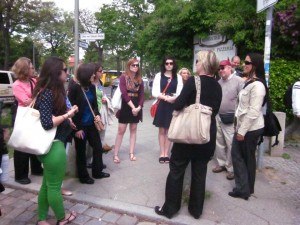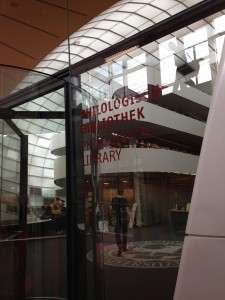
Dr. Elfriede Fürsich speaks to the group during a walking tour of Freie Universitat
(photo by Alexa Blanchard)
by Sara Tallerico
Dr. Elfriede Fürsich, a visiting professor at Freie Universitat in Berlin, specializes in issues of media globalization and journalism. Her lecture, “German Media During World War II” offered visiting Point Park students an insight on how German media structure originated.
Fürsich’s lecture featured various prominent figures in German media that allowed students to grasp how certain media operations developed
“A lot of media structure today is because of World War II,” Fürsich said, and no censorship edicts stand in direct opposition to what occurred back then. The Nazis also contradicted what was a very liberal media policy during the Weimar era in the 1920s, which she said was “very liberal and advanced.” She explained how the no censorship rules that now exist that came about because of the loathing to return to those days.
She offered a brief history of how media worked during World War II. The main principle of German media was Gleichschaltung, meaning “making the same.” This is a Nazi term for the process by which the Nazi regime successively established a system of totalitarian control over all aspects of society. Standard acts in Germany prior to World War II no longer applied.
Germany’s main strategy for spreading ideas and information was propaganda. Fürsich spoke of two prominent figures who largely spread propaganda throughout Germany during World War II. She spoke about Joseph Goebbels first. Goebbels was a German politician and the minister of public enlightenment and propagranda. He was one of Adolf Hitler’s closest associates and most devout followers. His main role was to centralize Nazi control of all aspects of German cultural and intellectual life, particularly the press and radio. A great speaker, Goebbels believed in the power of the radio as his propaganda machine. Radio broadcasts were heavily utilized to spread the ideas of the Nazi regime, which caught fire because of the dire economic situation Germans found themselves in at that time, a result of the war and the worldwide Great Depression.
The next prominent figure Fürsich discussed was filmmaker Leni Riefenstahl. Riefenstahl was a huge fan of Hitler. She often was part of the retinue for Hitler’s mass speeches and created documentaries regarding them. Her documentaries were showed at movie halls in Germany, and students were required to watch them. The documentaries always featured the latest technology, a patriotic style and they never sounded emotional.
Despite the subject matter, she has been emulated. “She developed an aesthetic used to this day in film and advertising,” Fürsich said.
Fürsich explained that with Riefenstahl’s documentaries came propaganda films. Most of these films were produced at the Universum Film AG, better known as the UFA. During the Third Reich, many propaganda films were produced such as “Derewige Jude” and “Münchhausen.” She said they were terrible depictions of Jews and Hitler’s opponents, and the only other films shown then were comedies, stories and musicals.
Post war, two media systems were created: one model for West Germany and another for East Berlin in keeping with the Allies control over the conquered country.
West Germany’s model was known as the Social Responsibility Model. This model consisted of a mixed system. The government did not control the media but checked on it in a responsible way.
In East Germany, Soviet officials relied on the Marxist-Leninist Model. This model utilized the media and journalists to educate the masses. The government completely controlled the media. With little to no freedom regarding media, journalists began a method referred to as “reading between the lines.” East Berlin housed many newspapers, and journalists were constantly being told what to write about from the government. However, journalists would often change words around to let the public know what was really going on, and West Germans continually interfered with the other side’s television broadcasts. Along with newspapers and TV news programs, East Berlin also had various television shows. One popular television show that Fürsich discussed was “The Black Channel.” This television show included recorded extracts from recent West German television programs re-edited to include a Communist commentary, but many areas – including Dresden and Neubrandenburg – couldn’t get it. She called them “The Valley of the Clueless.”
When the Berlin Wall fell and Germany underwent a reunification process, many East German journalists – those who covered art, music, sports, culture and more – “stayed great journalists,” she said. “But the political journalists had to go.”
Today, Germany has a legal framework that guarantees its media and journalists freedom of expression, and laws state there will be no censorship. The goal is more reporting for the people as opposed to reporting for government, though, and privacy is very important with libel laws not very different than what exists in the United States, she said.
In her first address, she explained Germany’s dual broadcast system – public and commercial – and noted that most papers in Germany are regional, although there are major national newspapers, two of which – Die Welt and Suddeutsche Zeitung – the Point Park group visited. The media have suffered a loss in advertising, but automatic subscription renewals for newspapers and some government funding for broadcast places them in a more solid position, she said. Tabloids like Bild have also become very popular and have taken the lead in political coverage.
While the advertising declines mirror the states, Fürsich said the media are turning to digitalization, but Germans haven’t taken to the Internet and social media as Americans and others have done. Germans are still readers; there are bookstores in all towns. She cited the fact that 72.4 Germans said they used the Internet in 2012, but while they will use Facebook, they don’t like Twitter.
Recent Point Park graduate Richelle Szypulski stated, “Dr. Fürsich’s lecture provided a wonderful understanding on the different media systems after World War II. She explained them in a simple, straightforward way that made it really easy for us to grasp.” And the lecture prepared the students for the media visits in both Berlin and Munich.
